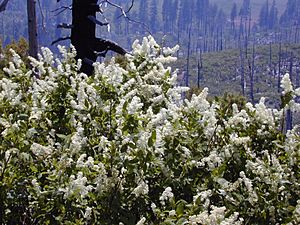Deer brush facts for kids
Ceanothus integerrimus, often called deer brush, is a type of woody shrub found in the western United States. You can spot it in states like Arizona, New Mexico, California, Oregon, and Washington. This plant usually grows in mountain woodlands, forests, and areas with fir, spruce, or Ponderosa pine trees. It's very common in the California chaparral and woodlands and the Sierra Nevada mountains.
Quick facts for kids Deer brush |
|
|---|---|
 |
|
| Scientific classification | |
| Genus: |
Ceanothus
|
| Species: |
integerrimus
|
| Synonyms | |
|
|
Contents
About Deer Brush
Deer brush is a deciduous shrub, which means it loses its leaves each year. It usually grows from 1 to 4 meters (about 3 to 13 feet) tall. Its branches spread out or grow straight up. This plant can handle dry conditions very well.
Its stems are round and can be yellow or pale green. They might have small, soft hairs or stiff, sharp hairs that lie flat against the stem.
Leaves, Flowers, and Fruit
The leaves of the deer brush are shiny and fall off each year. They are 2.5 to 8 centimeters (about 1 to 3 inches) long and grow one after another along the stems. The leaf stems are short, less than 15 millimeters (about half an inch) long.
The leaves can be shaped like a spear, an oval, or a wide egg. They often have one or two main veins starting from the base. They are usually thin with a pointed or rounded tip. The edges of the leaves can be smooth or have small teeth, especially near the tip. The top of the leaves is light green and might have tiny hairs that you can only see with a magnifying glass. The undersides of the leaves are also hairy and lighter in color.
The flowers are usually white or blue, but sometimes they can be pink. They grow in clusters up to 15 centimeters (about 6 inches) long. Each flower has both male and female parts.
The fruit is a sticky, round capsule about 4–5 millimeters (about 0.16–0.2 inches) wide. It has a small ridge on top. When the fruit splits open, it shoots out the seeds.
How Deer Brush Grows
Deer brush can grow in a few ways:
- From seeds.
- By growing new shoots from its base or stems.
- By layering, which happens when a branch touches the soil and grows roots, forming a new plant.
Some types of Ceanothus might not grow back from their roots after a fire. Most other plants can regenerate this way. Bees are the main helpers for pollinating deer brush flowers.
Deer brush plants start making seeds when they are about four years old. Many seeds can be found in the top layer of soil where deer brush grows. These seeds can stay alive for 24 years or even longer!
Seeds usually need something to break their hard outer shell before they can sprout. This can happen from a fire, which cracks the seed coat, or from physical disturbance. Seeds grow best about 1 inch deep in shady areas in the spring, after their outer shell has been broken.
Varieties of Deer Brush
There are four slightly different types, or varieties, of Ceanothus integerrimus. Scientists tell them apart mainly by their leaf shapes and flower colors:
- Ceanothus integerrimus var. californicus: Its leaves are oval, spear-shaped, or egg-shaped, with three veins from the base. The leaf surfaces have small hairs, and the undersides are less hairy. Flowers are usually white or blue.
- Ceanothus integerrimus var. integerrimus: This is the main variety.
- Ceanothus integerrimus var. macrothyrsus: Its leaves are oblong or egg-shaped, with three veins at the base. Both the top and bottom of the leaves are hairy. Flowers are white.
- Ceanothus integerrimus var. puberulus: Its leaves are oval, spear-shaped, or egg-shaped, with three veins from the base. Both sides of the leaves are hairy. Flowers are white.
Deer brush can also mix with other Ceanothus species, like Lemmon's ceanothus and mountain whitethorn, to create new types of plants.
Deer Brush in Nature

C. integerrimus is very important for forests to grow back after wildfires. It helps by adding nitrogen to the soil, which is a key nutrient for plants. It does this because its roots work with special bacteria that can take nitrogen from the air and put it into the soil.
Many animals eat deer brush. Mule deer especially like to feed on it. Porcupines and quail have also been seen eating its stems and seeds. The leaves are a good source of protein for animals, and both stems and leaves have a lot of calcium. The nutritional value of the leaves changes with the seasons, being best from fall to early spring.
Uses by People
The Indigenous peoples of California have traditionally used parts of the deer brush plant. For example, they used its branches to help women after childbirth. The Miwok Indians of Northern California also used the branches of this plant to weave beautiful and complex baskets. The Concow tribe calls this tree hē′-bē in their language.
See also
 In Spanish: Ceanothus integerrimus para niños
In Spanish: Ceanothus integerrimus para niños

